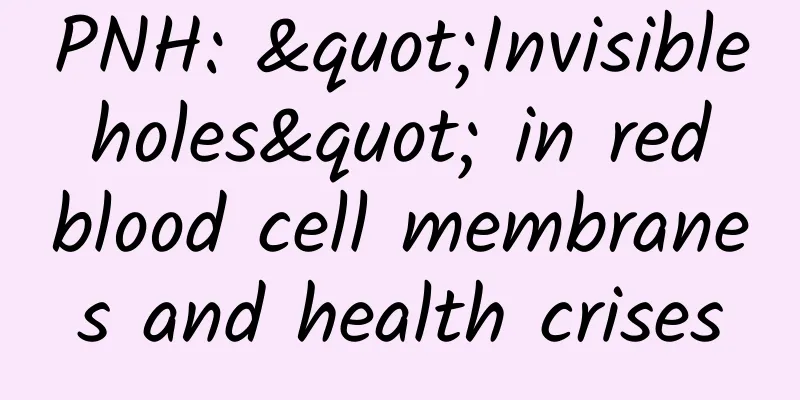PNH: "Invisible holes" in red blood cell membranes and health crises

|
Author: Han Bing, Chief Physician, Peking Union Medical College Hospital Reviewer: Jiang Qian, Chief Physician, Third Medical Center, PLA General Hospital PNH, the full name of which is paroxysmal nocturnal hemoglobinuria, is a rare, acquired, non-hereditary blood disease. Although its name is difficult to pronounce, it contains rich medical information: paroxysmal, meaning that symptoms may occur intermittently; nocturnal, implying that symptoms are somehow related to the sleep state; and hemoglobinuria is one of the characteristic clinical manifestations of the disease. The pathogenesis of PNH is rooted in the mutation of the PIG-A gene in hematopoietic stem cells. Under normal circumstances, the PIG-A gene is responsible for encoding a key enzyme that is involved in the synthesis of complement regulatory proteins on the red blood cell membrane. However, when the PIG-A gene mutates, the synthesis of this enzyme is blocked, resulting in the loss of complement regulatory proteins on the red blood cell membrane, which in turn triggers a series of chain reactions. Figure 1 Original copyright image, no permission to reprint It is worth noting that PNH is not a hereditary disease, but an acquired disease. Although the specific cause of PIG-A gene mutation has not yet been determined, there is a widely accepted "two-hit" theory. This theory holds that under certain specific circumstances, such as aplastic anemia and other conditions where hematopoietic function is impaired, cell clones with PIG-A gene mutations are selected and gradually become dominant clones, thereby causing PNH. This process may be related to the pressure and compensatory mechanism faced by the hematopoietic system. In terms of age of onset and epidemiology, there is no clear age limit for the onset of PNH, but there are two peak periods, one in adolescence to young adults (about 10-40 years old) and the other in the elderly (over 60 years old). Globally, PNH is a rare disease, with only 1-2 cases per million people. China lacks accurate epidemiological data, but the incidence rate in the north is higher than in the south, which is similar to the distribution of patients with aplastic anemia. The clinical manifestations of PNH are diverse and complex, and can be summarized into three main characteristics: bone marrow failure, hemolysis, and thrombosis. Bone marrow failure is manifested as blood cell reduction, and patients may experience anemia, leukopenia, and thrombocytopenia, similar to aplastic anemia. Hemolysis is one of the characteristic clinical manifestations of PNH. When the complement regulatory protein on the red blood cell membrane is missing, the red blood cells are susceptible to complement attack and rupture, causing hemoglobin to be released into the urine, forming hemoglobinuria. The patient's urine may be red, brown, or even soy sauce-colored, and in severe cases, hematuria may even occur. Figure 2 Original copyright image, no permission to reprint In addition, thrombosis is also a major threat to PNH patients. Thrombosis can occur in various parts of the body, but abdominal vein thrombosis is the most common. Patients may experience symptoms such as abdominal pain, intestinal obstruction, and portal hypertension. Lower limb vein thrombosis may cause discomfort such as leg swelling and soreness. More seriously, thrombosis may also occur in key parts such as the intracranial venous sinuses and lungs, causing life-threatening symptoms such as headaches, increased intracranial pressure, dyspnea, and hemoptysis. Since the clinical manifestations of PNH are diverse and complex, the diagnosis process is often challenging. Doctors need to consider the patient's medical history, symptoms, signs and laboratory test results and make a comprehensive analysis and judgment. Flow cytometry is used to detect the expression levels of CD55 and CD59 (complement regulatory proteins on the red blood cell membrane). If an abnormal decrease is found, the diagnosis of PNH is supported. In differential diagnosis, it is necessary to distinguish it from aplastic anemia and myelodysplastic syndrome (MDS). Although the latter two have blood cell reduction, they do not have abnormal expression of PNH-specific markers CD55 and CD59. Figure 3 Original copyright image, no permission to reprint |
<<: [Medical Q&A] If you suspect femoral head necrosis, what tests should you do?
>>: [Medical Q&A] Spinal pain is accompanied by night sweats. What disease might I have?
Recommend
What causes swollen glans clitoris?
A woman's clitoris is a very private part. In...
Is it better for children to be vaccinated as early as possible?
In recent days, you may have noticed that there a...
A girl has a black hair on her chin
There are many reasons why a girl grows a black h...
What is white belt?
Secretion is female secretion, which is a mixture...
Is it normal for women to have odor down there?
Different girls have different genital odors, and...
Why does a woman feel pain in her left chest when she is tired?
We all know that in life, physical work is usuall...
Estrogen changes during pregnancy
Most women need to go through the process of preg...
How many days after childbirth can acupuncture be used
I believe many people are familiar with acupunctu...
What is the difference between anterior and posterior pelvic tilt?
The pelvis is very important to everyone, and it ...
What causes pectus excavatum?
Many people have not heard of pectus excavatum, b...
To prevent and control myopia in children and adolescents, you may want to try these traditional Chinese medicine treatments
"Online classes", "Complete homewo...
What should girls do if they have breast hyperplasia?
The symptoms of breast hyperplasia are breast hyp...
Are the ten days before menstruation the dangerous period?
What is the dangerous period of pregnancy and wha...
Neurodecision Science - Four Steps to Decision Making
Neuroeconomics - Four Steps to Decision Making: H...
How to formulate dietary policies? How to eat healthier? All these are inseparable from nutrition research.
Produced by: Science Popularization China Author:...









